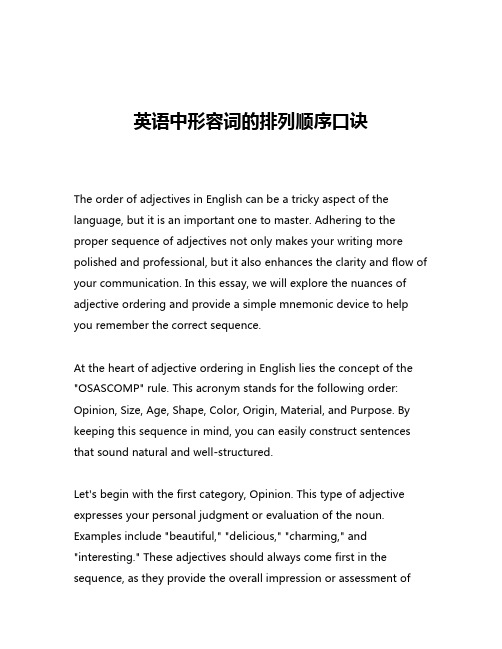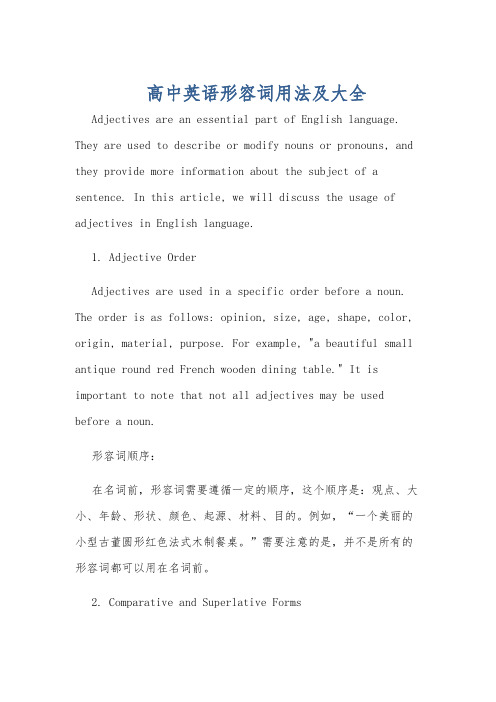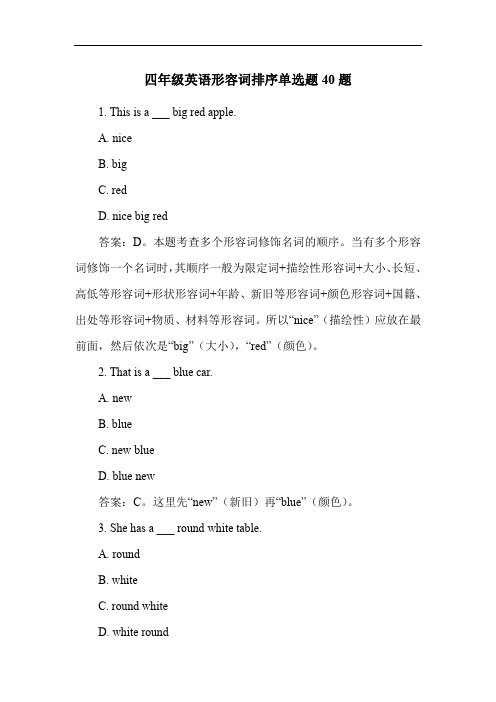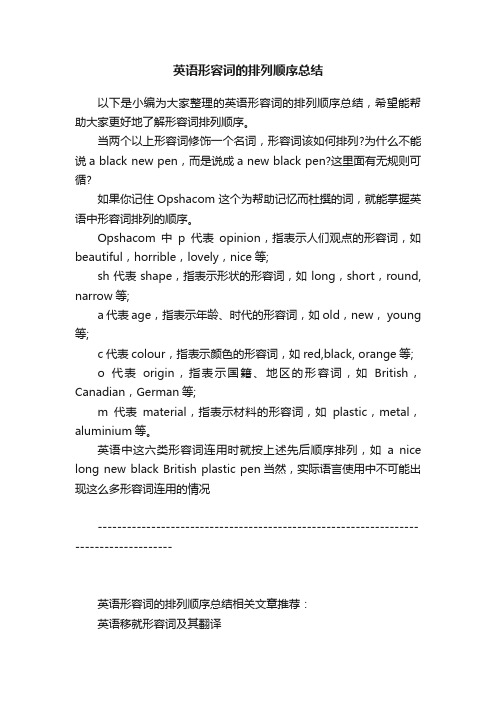order-of-adjectives-多个形容词排序
英语中形容词的排列顺序口诀

英语中形容词的排列顺序口诀The order of adjectives in English can be a tricky aspect of the language, but it is an important one to master. Adhering to the proper sequence of adjectives not only makes your writing more polished and professional, but it also enhances the clarity and flow of your communication. In this essay, we will explore the nuances of adjective ordering and provide a simple mnemonic device to help you remember the correct sequence.At the heart of adjective ordering in English lies the concept of the "OSASCOMP" rule. This acronym stands for the following order: Opinion, Size, Age, Shape, Color, Origin, Material, and Purpose. By keeping this sequence in mind, you can easily construct sentences that sound natural and well-structured.Let's begin with the first category, Opinion. This type of adjective expresses your personal judgment or evaluation of the noun. Examples include "beautiful," "delicious," "charming," and "interesting." These adjectives should always come first in the sequence, as they provide the overall impression or assessment ofthe object being described.Next, we have Size. Adjectives that describe the physical dimensions of an object, such as "large," "small," "tiny," and "massive," should follow the Opinion adjectives. It is important to note that size can also be relative, so words like "huge" and "minuscle" can also fall into this category.The third category is Age. Adjectives that indicate the temporal aspect of the noun, such as "new," "old," "ancient," and "young," should come after the Size adjectives. These words help to establish the temporal context of the object being described.Shape is the fourth category in the OSASCOMP rule. Adjectives that describe the physical form or geometry of an object, such as "round," "square," "rectangular," and "cylindrical," should follow the Age adjectives.Color is the fifth category, and it is perhaps the most straightforward. Adjectives that denote the hue or shade of an object, such as "red," "blue," "green," and "golden," should come after the Shape adjectives.The sixth category is Origin, which refers to the source or provenance of the object. Adjectives like "French," "Italian," "Chinese," and"Parisian" should be placed after the Color adjectives.The seventh category is Material, which describes the substance or composition of the object. Adjectives such as "wooden," "metal," "glass," and "leather" should come after the Origin adjectives.Finally, the eighth and last category is Purpose, which describes the function or intended use of the object. Adjectives like "cooking," "decorative," "office," and "travel" should be placed at the end of the sequence.Now, let's put this all together with an example sentence:"The beautiful, large, old, round, red, French, wooden, cooking pot was placed on the stove."In this sentence, the adjectives are arranged in the correct OSASCOMP order: Opinion (beautiful), Size (large), Age (old), Shape (round), Color (red), Origin (French), Material (wooden), and Purpose (cooking).It's important to note that not all sentences will require every single category of adjectives. The key is to remember the overall sequence and to apply it as needed, based on the specific details you wish to convey about the noun.To help cement this concept in your mind, here's a simple mnemonic device:"Oh, So Adorable, Shiny, Circular, Organic, Metallic, Perfect!"By reciting this phrase, you can quickly recall the proper order of adjectives: Opinion, Size, Age, Shape, Color, Origin, Material, and Purpose.In conclusion, mastering the order of adjectives in English is a valuable skill that can elevate your writing and communication. By following the OSASCOMP rule and utilizing the mnemonic device, you can confidently construct sentences that are not only grammatically correct but also aesthetically pleasing and easy to understand. With practice and repetition, this aspect of the English language will become second nature, allowing you to express your ideas with greater clarity and precision.。
五年级英语多个形容词排序单选题40题

五年级英语多个形容词排序单选题40题1.She is a _____ girl.A.beautiful tallB.tall beautifulC.beautiful and tallD.tall and beautiful答案:B。
多个形容词修饰名词时,其顺序为:限定词、描绘性形容词、大小、长短、高低等形容词、形状、年龄、新旧、颜色、国籍、材料等。
“tall”表示高矮,属于大小、长短、高低等形容词,“beautiful”属于描绘性形容词,所以顺序为tall beautiful。
A 选项顺序错误;C 和D 选项中“and”连接的两个形容词并列使用,不符合多个形容词的一般排序规则。
2.The _____ boy has big blue eyes.A.handsome littleB.little handsomeC.handsome and littleD.little and handsome答案:B。
理由同上,“little”表示大小,“handsome”是描绘性形容词,顺序为little handsome。
A 选项错误;C 和D 选项不符合排序规则。
3.He is a _____ man.A.tall strongB.strong tallC.tall and strongD.strong and tall答案:A。
“tall”表示高矮,“strong”表示强壮程度,属于描绘性形容词,顺序为tall strong。
B 选项错误;C 和D 选项不符合一般排序规则。
4.The _____ lady has long black hair.A.beautiful tallB.tall beautifulC.tall and beautifulD.beautiful and tall答案:B。
“tall”表示高矮,“beautiful”是描绘性形容词,顺序为tall beautiful。
A 选项错误;C 和D 选项不符合排序规则。
高中英语形容词用法及大全

高中英语形容词用法及大全Adjectives are an essential part of English language. They are used to describe or modify nouns or pronouns, and they provide more information about the subject of a sentence. In this article, we will discuss the usage of adjectives in English language.1. Adjective OrderAdjectives are used in a specific order before a noun. The order is as follows: opinion, size, age, shape, color, origin, material, purpose. For example, "a beautiful small antique round red French wooden dining table." It is important to note that not all adjectives may be used before a noun.形容词顺序:在名词前,形容词需要遵循一定的顺序,这个顺序是:观点、大小、年龄、形状、颜色、起源、材料、目的。
例如,“一个美丽的小型古董圆形红色法式木制餐桌。
”需要注意的是,并不是所有的形容词都可以用在名词前。
2. Comparative and Superlative FormsAdjectives have comparative and superlative forms. The comparative form is used to compare two things while the superlative form is used to compare three or more things. For example, "John is taller than Tom" (comparative) and "John is the tallest person in the room" (superlative).比较级和最高级:形容词有比较级和最高级形式。
Adjectives

The Degree of Adjectives:big small happy scary funny sad open closed clean quiet dirty hungry thirsty cute smart ugly clever friendly beautiful shy lazy dangerous safe young terrible hot cold cool warm surprised relaxed excited excitng successful busy strict tired interesting boring difficult relaxing curly different tall long short fat thin heavy popular good-looking special tasty smelly nice unfriendly awful delicious expensive cheap crowded colorful active healthy unhealthy stressed out early traditional weak angry important famous quick worried outgoing calm wild serious athletic necessary fast free straight late sore balancedHumid primary opposite fantasticwestern eastern another wholeold bad ill badly good well little many much farloudly quickly形容词变副词规则:1.直接加lyquiet- quietly beautiful_____ safe____ successful2.辅音字母加y结尾,去y为i,再加erhappy- happily angry_____ healthy____ unfriendly____3.去e,再加ly terrible-terribly糟糕地形容词或副词原级用法:1.单独描述某些人或物He is tall.2.将两者相比较,最后得出的程度,相一致Eg.他与我一样大。
Degrees of Adjectives and Adverbs

(3)“甲+be+the+形容词比较级+of the two+„„”表示“甲是两者中较„„的”。 例如: Look at the two boys. My brother is the taller of the two.看那两个男孩,我弟弟是两个当中较高的那个。 (4)“比较级+and+比较级”表示“越来越„„”。 例如,He is getting taller and taller.他变得越来越高了。 The flowers are more and more beautiful.花儿越来越漂亮。 He does his homework more and more carefully.他做作业越来越认真了。 (5)“the+比较级,the+比较级”表示“越„„,越„„”。 例如,The more careful you are,the fewer mistakes you’ll make.你越认真,犯的错误越少。 (6)“特殊疑问词+be+形容词比较级,甲or乙?” 例如,Which is bigger,the earth or the moon?哪一个大,地球还是月球? “特殊疑问词+实意动词+副词比较级,甲or乙?” 例如,Who draws better,Jenny or Danny?谁画得比较好,詹妮还是丹尼? 3.最高级常用句型结构 (1)“主语+be+the+形容词最高级+单数名词+in/of短语”表示“„„是„„中最„„的”。 例如,Tom is the tallest in his class./of all the students.汤姆是他们班上/所有学生当中最高的。 This apple is the biggest of the five. 这个苹果是五个当中最大的。 “主语+实意动词+(the)+副词最高级+单数名词+in/of短语”表示“„„是„„中最„„的”。 例如,I jump (the) farthest in my class.我是我们班跳得最远的。 (2)“主语+be+one of the+形容词最高级+复数名词+in/of短语”表示“„„是„„中最„„之一”。 例如,Beijing is one of the largest cities in China.北京是中国最大城市之一。 (3)“特殊疑问词+be+the+最高级+甲,乙,or丙?”用于三者以上的比较。 例如,Which country is the largest,China,Brazil or Canada?哪一个国家最大,中国,巴西还是加拿大? “特殊疑问词+实意动词+(the)+副词最高级+甲,乙,or丙?”用于三者以上的比较 例如,Which season do you like (the) best,spring,summer or autumn?你最喜欢哪一个季节,春天,夏天还是秋天?
形容物的英文形容词的使用方法

形容物的英文形容词的使用方法Adjectives are an essential part of the English language, serving to describe and modify nouns. They provide color and detail to our speech and writing, allowing us to convey more precise and vivid information about the objects and qualities we are dis cussing. Here’s how to effectively use adjectives英文版:1. Placement: Adjectives typically come before the noun they modify, as in "The beautiful garden" or "a delicious meal."2. Order of Adjectives: When using multiple adjectives, there is a general order to follow: quantity or number,quality or opinion, size, age, shape, color, proper adjective (often nationality, other place, or material), and purpose or qualifier. For example, "a charming old red wooden Italian table."3. Comparative and Superlative Forms: To compare two things, use the comparative form (e.g., "bigger," "brighter"), and for comparing three or more, use the superlative form(e.g., "biggest," "brightest").4. Adjective Clauses: These are clauses that provide additional information about a noun. They often start with relative pronouns such as "which," "who," or "that." For example, "The book that I read was fascinating."5. Adjective Phrases: A phrase can act as an adjective, providing more detailed information. For example, "The manwith a big smile walked into the room."6. Adjectives Ending in -ing and -ed: Adjectives endingin -ing describe the effect something has on people, while those ending in -ed describe how something itself is. For example, "The movie was boring" (the movie itself is boring) versus "The audience was bored" (the audience felt bored).7. Avoiding Redundancy: Be careful not to use redundant adjectives, which are unnecessary and can make your writing less clear. For example, "The only unique solution" is redundant because "unique" already implies that there is only one.8. Idiomatic Expressions: Some adjectives are used infixed expressions, and it's important to learn these to sound natural in English. For example, "I’m feeling u nder the weather" is a common way to say you are sick.9. Adjectives as Nouns: In some cases, adjectives can be used as nouns, often referring to a group of people or things. For example, "The rich and the poor have different perspectives."10. Adjectives with Prepositions: Certain adjectives are commonly followed by specific prepositions. For example, "interested in" or "afraid of."By understanding and applying these principles, you can enhance your English writing and speaking with more descriptive and engaging language.。
四年级英语形容词排序单选题40题

四年级英语形容词排序单选题40题1. This is a ___ big red apple.A. niceB. bigC. redD. nice big red答案:D。
本题考查多个形容词修饰名词的顺序。
当有多个形容词修饰一个名词时,其顺序一般为限定词+描绘性形容词+大小、长短、高低等形容词+形状形容词+年龄、新旧等形容词+颜色形容词+国籍、出处等形容词+物质、材料等形容词。
所以“nice”( 描绘性)应放在最前面,然后依次是“big” 大小),“red” 颜色)。
2. That is a ___ blue car.A. newB. blueC. new blueD. blue new答案:C。
这里先“new” 新旧)再“blue” 颜色)。
3. She has a ___ round white table.A. roundB. whiteC. round whiteD. white round答案:C。
先“round” 形状)后“white” 颜色)。
4. He bought a ___ small black dog.A. blackB. smallC. black smallD. small black答案:D。
先“small” 大小)后“black” 颜色)。
5. There is a ___ old brown chair.A. oldB. brownC. old brownD. brown old答案:C。
先“old” 年龄、新旧)后“brown” 颜色)。
6. The big black dog is very friendly. Which is the correct order of the adjectives?A. big blackB. black bigC. big and blackD. black and big答案:A。
本题考查多个形容词修饰名词时的顺序,大小在前,颜色在后。
英语形容词的排列顺序总结

英语形容词的排列顺序总结以下是小编为大家整理的英语形容词的排列顺序总结,希望能帮助大家更好地了解形容词排列顺序。
当两个以上形容词修饰一个名词,形容词该如何排列?为什么不能说a black new pen,而是说成a new black pen?这里面有无规则可循?如果你记住Opshacom这个为帮助记忆而杜撰的词,就能掌握英语中形容词排列的顺序。
Opshacom中p代表opinion,指表示人们观点的形容词,如beautiful,horrible,lovely,nice等;sh代表shape,指表示形状的形容词,如long,short,round, narrow等;a代表age,指表示年龄、时代的形容词,如old,new, young 等;c代表colour,指表示颜色的形容词,如red,black, orange等;o代表origin,指表示国籍、地区的形容词,如British,Canadian,German等;m代表material,指表示材料的形容词,如plastic,metal,aluminium等。
英语中这六类形容词连用时就按上述先后顺序排列,如a nice long new black British plastic pen当然,实际语言使用中不可能出现这么多形容词连用的情况--------------------------------------------------------------------------------------英语形容词的排列顺序总结相关文章推荐:英语移就形容词及其翻译英语多个形容词如何排序:排列口诀职场英语:简历中不恰当的形容词有哪些英语四级常用形容词同介词的搭配英语新词汇的特点及翻译英语形容词的排列顺序总结当两个以上形容词修饰一个名词,形容词该如何排列?为什么不能说a black new pen,而是说成a new black pen?这里面有无规则可循? 如果你记住Opshacom这个为帮助记忆而杜撰的词,就能掌握英语中形容词排列的顺序。
